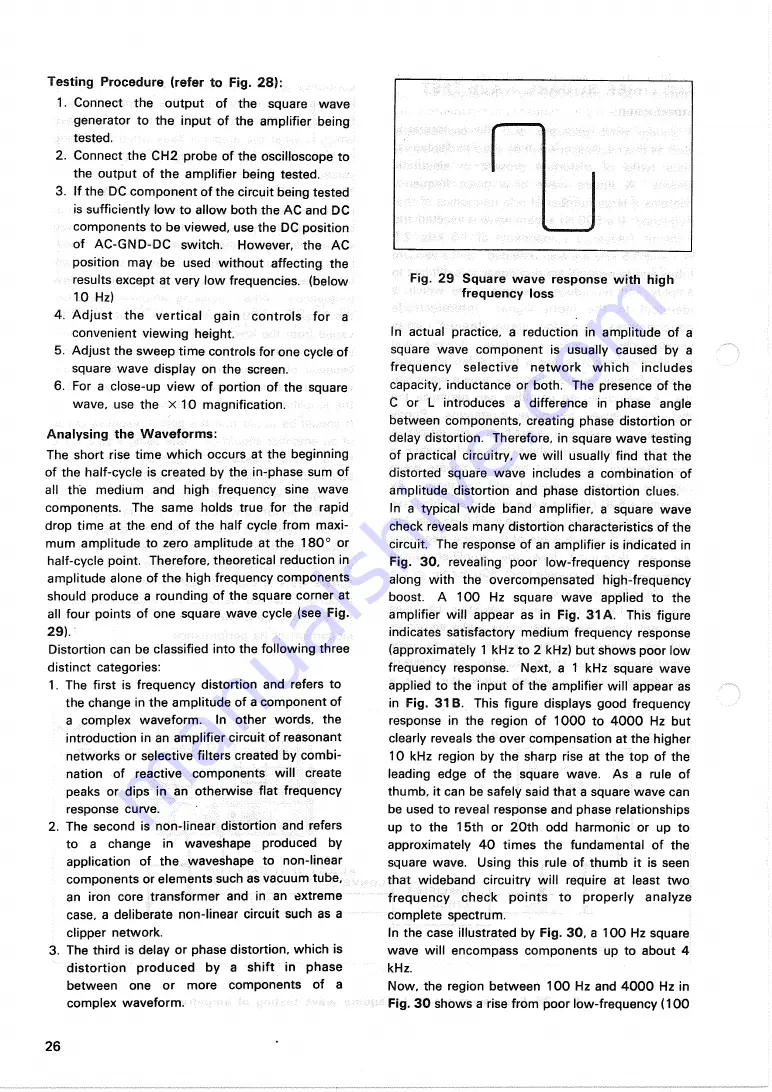
Testing Procedure (refer to Fig. 28):
1. Connect the output of the square wave
generator to the input of the amplifier being
tested.
2. Connect the C H 2 probe of the oscilloscope to
the output of the amplifier being tested.
3. If the DC component of the circuit being tested
is sufficiently low to allow both the A C and DC
components to be viewed, use the DC position
of A C - G N D - D C switch. However, the A C
position may be used without affecting the
results except at very low frequencies, (below
10 Hz)
4. Adjust the vertical gain controls for a
convenient viewing height.
5. Adjust the sweep time controls for one cycle of
square wave display on the screen.
6. For a close-up view of portion of the square
wave, use the x 10 magnification.
A n a l y s i n g the W a v e f o r m s :
The short rise time which occurs at the beginning
of the half-cycle is created by the in-phase sum of
all the medium and high frequency sine wave
components. The same holds true for the rapid
drop time at the end of the half cycle from maxi-
mum amplitude to zero amplitude at the 1 8 0 ° or
half-cycle point. Therefore, theoretical reduction in
amplitude alone of the high frequency components
should produce a rounding of the square corner at
all four points of one square wave cycle (see F i g .
29).
Distortion can be classified into the following three
distinct categories:
1. The first is frequency distortion and refers to
the change in the amplitude of a component of
a complex waveform. In other words, the
introduction in an amplifier circuit of reasonant
networks or selective filters created by combi-
nation of reactive components will create
peaks or dips in an otherwise flat frequency
response curve.
2. The second is non-linear distortion and refers
to a change in waveshape produced by
application of the waveshape to non-linear
components or elements such as vacuum tube,
an iron core transformer and in an extreme
case, a deliberate non-linear circuit such as a
clipper network.
3. The third is delay or phase distortion, which is
distortion produced by a shift in phase
between one or more components of a
complex waveform.
In actual practice, a reduction in amplitude of a
square wave component is usually caused by a
frequency selective network w h i c h includes
capacity, inductance or both. The presence of the
C or L introduces a difference in phase angle
between components, creating phase distortion or
delay distortion. Therefore, in square wave testing
of practical circuitry, w e will usually find that the
distorted square w a v e includes a combination of
amplitude distortion and phase distortion clues.
In a typical wide band amplifier, a square w a v e
check reveals many distortion characteristics of the
circuit. The response of an amplifier is indicated in
Fig. 3 0 , revealing poor low-frequency response
along with the overcompensated high-frequency
boost. A 100 Hz square wave applied to the
amplifier will appear as in F i g . 3 1 A. This figure
indicates satisfactory medium frequency response
(approximately 1 kHz to 2 kHz) but shows poor low
frequency response. Next, a 1 kHz square w a v e
applied to the input of the amplifier will appear as
in F i g . 3 1 B. This figure displays good frequency
response in the region of 1 0 0 0 to 4 0 0 0 Hz but
clearly reveals the over compensation at the higher
10 kHz region by the sharp rise at the top of the
leading edge of the square wave. A s a rule of
thumb, it can be safely said that a square w a v e can
be used to reveal response and phase relationships
up to the 15th or 20th odd harmonic or up to
approximately 4 0 times the fundamental of the
square wave. Using this rule of thumb it is seen
that wideband circuitry will require at least two
frequency c h e c k points to properly analyze
complete spectrum.
In the case illustrated by F i g . 3 0 , a 1 0 0 Hz square
wave will encompass components up to about 4
kHz.
Now, the region between 1 0 0 Hz and 4 0 0 0 Hz in
Fig. 3 0 shows a rise from poor low-frequency ( 1 0 0
2 6
Fig. 29 Square wave response with high
frequency loss
Содержание CS-1566A
Страница 5: ...CONTROLS ON PANELS FRONT PANEL Fig 1 REAR PANEL Fig 2 5...
Страница 33: ...SCHEMATIC DIAGRAM CS 1566A 33...























